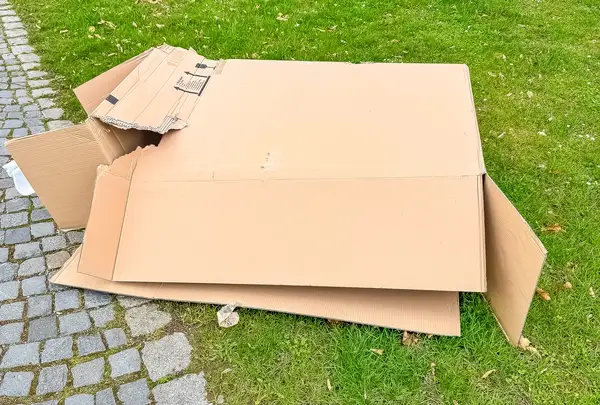Remember that stack of cardboard boxes sitting in your garage from your online shopping sprees? Don’t toss them in the recycling bin just yet! Those plain brown boxes could be the secret weapon your yard has been missing all along. From killing weeds to protecting plants, cardboard has some amazing uses that might just change how you garden forever. Who knew that the packaging from your latest impulse buy could save you hours of backbreaking yard work?
Make a weed barrier that actually works
Fighting weeds can feel like a never-ending battle, especially when those pesky plants keep coming back no matter how many times you pull them. That’s where cardboard comes in as your new best friend. By laying flattened boxes directly on trouble spots in your yard, you create a natural barrier that blocks sunlight from reaching weed seeds. The cardboard smothers existing weeds while preventing new ones from sprouting up. Unlike plastic weed barriers that can harm your soil over time, cardboard actually breaks down and improves your soil as it decomposes.
For this method to work best, make sure to remove any tape or labels from your boxes first, as these won’t break down easily. Overlap the edges of your cardboard pieces by at least six inches to prevent sneaky weeds from finding gaps. After placing your cardboard, wet it thoroughly and cover with a organic mulch like wood chips or straw about 2-3 inches deep. This not only keeps the cardboard in place but also helps it stay moist so it can break down properly. Within a few months, you’ll have weed-free areas and improved soil underneath.
Create new garden beds without digging
Want to add a new garden bed but dreading the thought of digging up all that grass and soil? Cardboard makes it super easy to create new planting areas without breaking your back. This method, often called “no-dig” or “lasagna gardening,” lets you build right on top of existing grass or weeds. Simply lay cardboard directly onto the area where you want your new bed, making sure to overlap the edges. The cardboard will kill the grass underneath while preserving all the good microorganisms in your soil that would otherwise be disturbed by digging.
After placing your cardboard base, spray it with water until it’s completely soaked. Then add layers of compost, soil, and garden soil on top, building up to at least 6-8 inches deep. The beauty of this method is that you can plant right away in the top layers for smaller plants, while the cardboard below slowly breaks down. By the time your plants’ roots need to go deeper, the cardboard will have decomposed enough to let them through. This approach saves hours of digging and is much gentler on your back and on the essential soil life that makes your garden thrive.
Protect your plants from frost damage
When surprise cold snaps threaten your garden, those cardboard boxes can become instant plant protectors. Instead of rushing to the store to buy expensive frost covers, simply place boxes over vulnerable plants in the evening when temperatures are predicted to drop. The cardboard creates a pocket of insulated air around your plants, keeping them several degrees warmer than the outside air. This simple trick can be the difference between plants surviving or dying when unexpected cold weather hits. Smaller boxes work great for individual plants, while larger boxes can cover entire rows.
For best results, place the boxes over your plants before sunset to trap the day’s warmth, and remove them in the morning once temperatures rise above freezing. If you’re dealing with wind, you might need to place a rock or brick on top to keep the box from blowing away. For extra protection during severe cold, wrap the outside of the box with blankets or bubble wrap for added insulation. Remember that this is a temporary solution—prolonged darkness isn’t good for plants—but it can be a lifesaver during those 1-2 night cold snaps that sometimes catch gardeners off guard during spring and fall.
Make free biodegradable seed starters
Starting seeds indoors is a great way to get a jump on the growing season, but those plastic seed trays can be expensive and wasteful. Cardboard boxes provide an eco-friendly alternative that costs absolutely nothing. Toilet paper rolls, small shipping boxes, and even cereal boxes can be transformed into perfect biodegradable seed starters. Simply cut cardboard into small containers, fill with seed starting mix, and plant your seeds. The best part? When it’s time to transplant, you can place the entire cardboard container directly into your garden soil where it will break down naturally.
If you’re using toilet paper rolls, fold one end closed and stand them upright in a waterproof tray. For boxes, cut them down to about 3-4 inches tall. Make sure to poke drainage holes in the bottom of any containers you create. The cardboard will hold moisture well but still allow excess water to drain. Seedlings grow strong root systems in cardboard containers, and when planted directly in the ground, the decomposing cardboard actually encourages roots to spread out into the surrounding soil. This method gives your plants a head start while keeping countless plastic trays out of landfills. Plus, you can use a seed starting mix to give your seedlings the best possible start.
Trap slugs and snails without chemicals
Slugs and snails can destroy a garden overnight, munching holes through your favorite plants and leaving slimy trails across your yard. But before you reach for harsh chemical solutions, try this simple cardboard trick that gardeners swear by. Place small pieces of dampened cardboard near vulnerable plants like hostas, lettuce, or strawberries in the evening. Slugs and snails are attracted to the dark, moist environment under the cardboard and will gather there to hide from the sun during the day. In the morning, simply flip over the cardboard and remove the pests that have collected underneath.
This method works because slugs and snails seek shelter during daylight hours, and cardboard provides the perfect hiding spot. For best results, check your cardboard traps each morning and dispose of any collected pests. You can either relocate them far from your garden or drop them in a bucket of soapy water. To make your traps even more effective, try baiting them with a sprinkle of organic fertilizer or cornmeal under the cardboard. The pests will be doubly attracted to both the shelter and the food. This method is completely free, uses materials you already have on hand, and avoids introducing potentially harmful chemicals into your garden ecosystem.
Create protective collars for young plants
Young seedlings face many threats in the garden, from cutworms that chew through stems to harsh winds that can damage tender plants. Cardboard collars offer a simple solution to protect your seedlings during their vulnerable early days. Cut toilet paper rolls or sturdy cardboard into 3-4 inch rings, and place these around newly transplanted seedlings, pressing them about an inch into the soil. These collars prevent cutworms from reaching your plants and create a mini windbreak to reduce stress on small plants. They’re especially useful for protecting valuable vegetable seedlings like tomatoes, peppers, and cabbage.
The beauty of cardboard collars is that they gradually break down as your plants grow, so there’s no need to remove them later. For added protection against pests, try cutting small notches along the top edge of your collars, which can discourage climbing insects. You can also make taller collars for plants that need extra wind protection in exposed garden areas. As a bonus, these collars can help define the watering area around each plant, ensuring that water goes straight to the roots instead of spreading out to weeds. If you’re growing plants that are particularly susceptible to pest damage, consider upgrading to plant guards for longer-lasting protection.
Improve your compost pile quality
A good compost pile needs a balance of “green” materials (like kitchen scraps and grass clippings) and “brown” materials (like fallen leaves and twigs). Cardboard falls into the brown category and can be a valuable addition to your compost bin, especially when you have an excess of green materials. Tearing cardboard into small pieces and mixing it into your compost provides carbon-rich material that helps absorb excess moisture and creates air pockets for better decomposition. This prevents your compost from becoming a smelly, soggy mess and speeds up the overall composting process.
For fastest decomposition, tear or cut your cardboard into pieces no larger than 4 inches square. Remove any tape, staples, or glossy printed areas before adding it to your pile. If your cardboard pieces are dry, try soaking them in water first to jump-start the breakdown process. Alternate layers of shredded cardboard with your kitchen scraps, grass clippings, and other compostable materials. The cardboard will gradually disappear as microorganisms break it down. Just be careful not to add too much at once—aim for no more than 20% of your total compost volume as cardboard. If you’re serious about composting, consider investing in a quality compost bin to make the process even easier.
Next time you receive a package, think twice before breaking down that box for recycling. From weed barriers to plant protectors, cardboard boxes have so many uses that can save you time, money, and effort in your yard. These simple cardboard hacks work with nature instead of against it, improving your soil while solving common garden problems. The best part? They’re completely free and keep these materials out of the waste stream a little longer. So start saving those delivery boxes—your garden will thank you!

